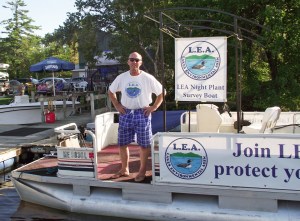BRIDGTON — If you look out your window some night this summer and think you see a space ship, it is probably the Lakes Environmental Association’s newest tool for finding milfoil and other invasive aquatic plants.
It all started last year when Peter Lowell, LEA’s executive director, got an unusual call from Francis Brautigam, regional fisheries biologist for the Maine Department of Inland Fisheries and Wildlife. Brautigam asked if LEA would help alert landowners on Highland Lake in Bridgton about a strangely lit boat IFW uses to conduct electro fishing surveys. Lowell emailed landowners as requested, but since it all sounded quite intriguing, asked if he could come along.
Electro fishing involves cruising the shoreline in a boat with incredibly bright spotlights that illuminate the lake bottom as they look for fish to “zap” for population studies. Periodically, a shock is sent into the water via a contraption that looks like an umbrella frame turned inside out. Fish are stunned, netted and placed in a holding tank, anesthetized with peppermint oil and ultimately weighed and measured. Then they’re returned to the water unharmed.
“It struck me that this same apparatus – minus the electro-shocking — might be the ideal way to survey for invasive aquatic plants,” Lowell said.
With support from an anonymous donor and the Ram Island Conservation Fund through the Maine Community Foundation, an old pontoon boat was outfitted with powerful lighting. Joe Gallinari, a Bridgton electrician, rewired the boat’s trailer, running lights and did all the work setting up the lights and associated equipment. Jim Allen of Naples Marina took charge of installing a new motor and getting the boat shipshape.
In July, LEA’s new night survey boat was deployed in Crystal Lake in Harrison for its first survey. This trip was followed by surveys of Trickey Pond in Naples and Peabody Pond in Bridgton, Sebago and Naples. Many more trips are planned.
On a dark, calm night, the boat’s bright lights can illuminate a wide swath of a lake’s bottom, revealing plants, as well as litter, golf balls and more. If suspicious plants are spotted, a buoy is dropped so divers can check them during daylight hours. The surveys done so far have taken about three hours on lakes about two miles long. Water clarity is the main variable, but even in lakes with low clarity, about six to eight feet of the water column is visible, providing a good look at the growing zone.
Lowell considers it a big improvement over the usual method of surveying for plants, which is more time-consuming and labor intensive. It involves looking through a tube or bucket scope from a boat. LEA has been conducting surveys with a snorkel team, which seems to give better visual coverage. But with the night survey boat, he hopes to increase the number of waters that can be checked each year.
“We are hoping that the night surveys will add a whole new level of efficiency,” Lowell said. “LEA looks forward to sharing the design and specifications with interested groups”
For more information or to go on a survey, contact Peter Lowell at 647-8580 or [email protected].

Comments are no longer available on this story